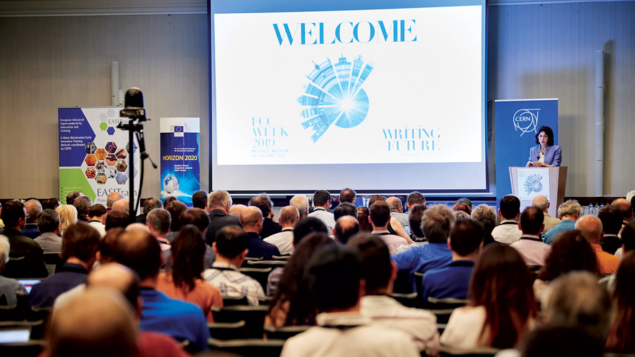
More than 400 researchers convened in Brussels from 24 to 28 June for the annual meeting of the Future Circular Collider (FCC) study. In addition to innovations in superconductivity, high-field magnets, superconducting radio-frequency systems and civil-engineering studies, discussions sought to clarify issues surrounding the physics research topics that FCC can address.
The meeting also marked the final event of the Horizon 2020 EuroCirCol project – a European Union project to produce a conceptual design study for a post-LHC research infrastructure based on an energy-frontier 100 TeV circular hadron collider. Since June 2015 the project has produced a wealth of results in high-tech domains via the collaborative efforts of partners in Europe and other countries such as the US, Japan, Korea and Russia. These include impressive progress toward 16 T magnets and in the performance of superconducting wires. Breakthroughs in both fields, such as a first accelerator-type magnet exceeding 14 T (see Advanced dipole sets high-field record) and an increase in the critical current density of Nb3Sn wire, promise to significantly reduce the costs of exploring the high-energy frontier and could find practical applications outside particle physics.
The four-volume FCC conceptual design report was also presented. Authored by 1350 people from 150 institutes, the report “underlines the global attractiveness of the FCC and documents the far-reaching benefits that the project can have for Europe and future generations,” said Frédérick Bordry, CERN director for accelerators and technologies.
A wide range of talks focused on a future circular lepton collider (FCC-ee) as the first step of the FCC programme, followed by an energy-frontier proton collider (FCC-hh). Results testify to the technological readiness of the FCC-ee, which could be operational by the end of the 2030s and therefore allow time to develop the novel technologies required for a 100 TeV proton–proton collider.
In his keynote talk, Nima Arkani- Hamed of the Institute for Advanced Study highlighted the importance of scrutinising the Higgs boson at a post-LHC machine. Speakers also stressed the complementarity between the different FCC options in searching for dark-matter candidate particles and other new physics. Finally, the potential for studying the strong interaction with heavy-ion collisions, and detailing parton distribution functions with a proton–electron interaction point, were demonstrated.
The sustainability of research infrastructures and the assessment of their societal impact were other highlights of FCC week 2019, as discussed at a special “Economics of Science” workshop. Experts from the field of economics shared lessons learned with representatives from CERN and other research organisations, including SKA, ESA and ESS, demonstrating the many benefits beyond physics that major international projects bring.







